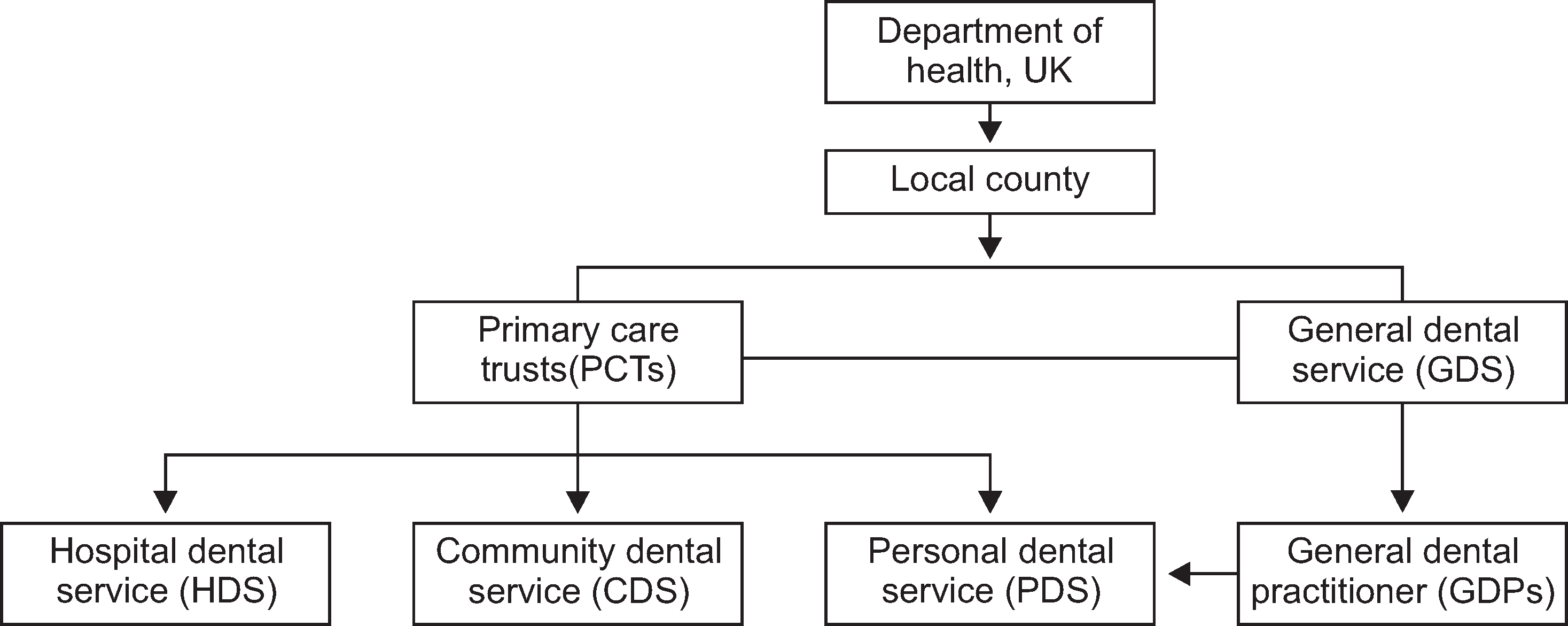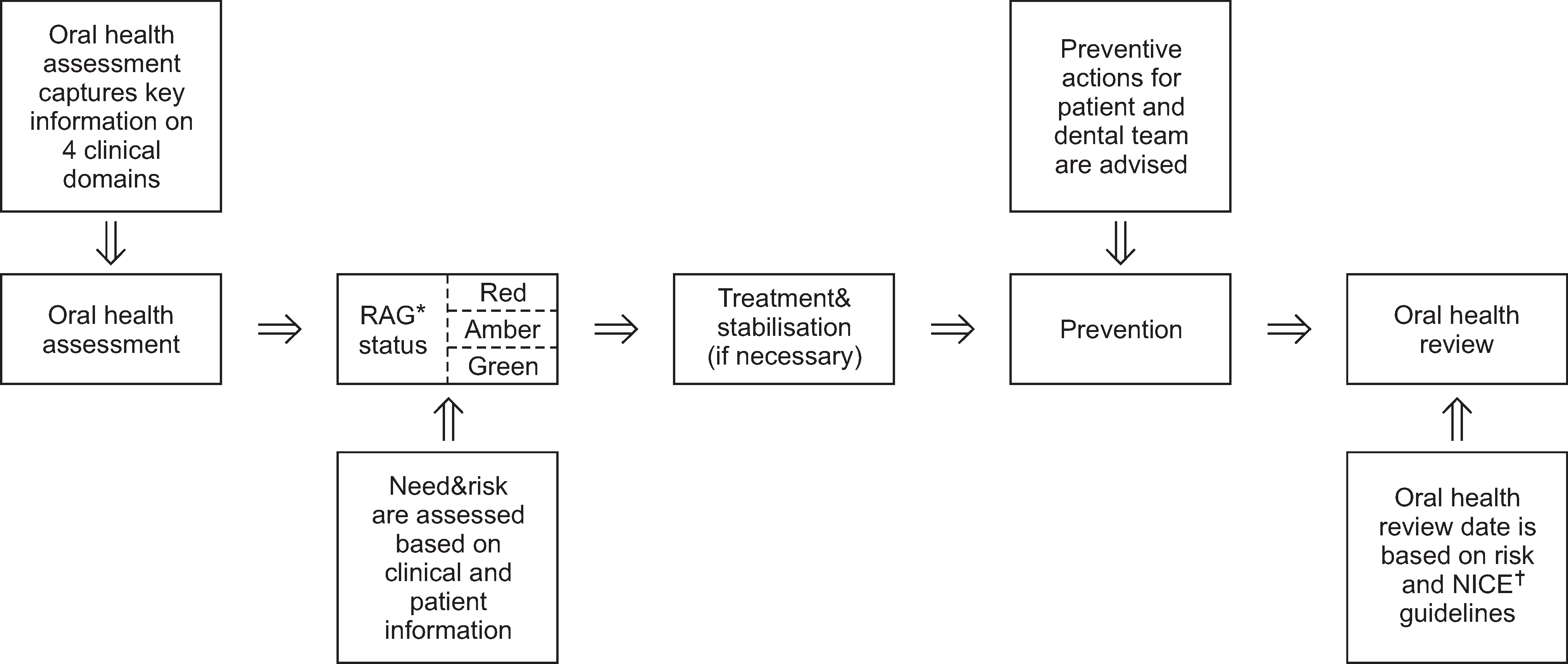Abstract
Objectives
Since 2000, the National Health Service (NHS) in the United Kingdom (UK) has challenged for a large-scale reforms. This study aims to review those reforms to reflect in the dental care system in Korea.
Methods
Reports and papers that were published from 2000 to 2015 and were related to the NHS dental care system and reforms were searched. Among them, official reports from the government or organization were prioritized.
Results
In 2002, the “NHS Dentistry: Options for Change” report suggested rebuilding the structure to meet the standard of care, improving the remuneration system, and modernizing the workforce. Eight years later, the government proposed the “NHS Dental Contract: Proposals for Pilots” to improve accessibility to oral health and dental care. The pilot was based on three elements: registration, capitation, and quality. In 2015, the Department of Health announced the “Dental Contract Reform: Prototypes.” These prototypes include the clinical pathway, measurement and remuneration by quality of care, and a weighted capitation and quality model reimbursement system.
Conclusions
The changes to the UK dental care system has implications. First, national coverage should be extended to improve accessibility to dental care. Second, the dental care system is necessary to reform focused on patient-centered and prevention. Third, registration and remuneration by quality of care needs to be introduced. Fourth, change should start from the basic steps, such as forming consensus or preparing manuals, to strengthening personnel and conducting a pilot study. Most of all, the new system will center on clinical leadership.
Go to : 
References
1. Kim CH. Function and importance of health security. Theories of Health Security. Seoul: Hanul Academy;2009. p. 68–104.
2. United Nations Development Programme (UNDP). Human Development Report 1994. New York: United Nations Development Programme (UNDP);1994. p. 1–11.
3. Commission on Human Security. Human Security Now. New York: United Nations;2003.
4. Ruger JP. Rethinking equal access: agency, quality, and norms. Glob Public Health. 2007; 2:78–96.

5. Oliver A, Mossialos E. Equity of access to health care: outlining the foundations for action. J Epidemiol Community Health. 2004; 58:655–658.

6. McArdle LW, Renton T. The effects of NICE guidelines on the management of third molar teeth. Br Dent J. 2012; 213:E8.

7. National Health Service. NHS Plan: A Plan for Investment, A Plan for Reform. London: National Health Service;2000. p. 17–21.
8. Byon JY, Lee HY, Ahn SJ, Kim KA. The 8th, United Kingdom. Trends of medical social security system in several countries. Seoul: National Health Insurance Corporation, Health Insurance Policy Research Institute;2014.
9. Department of Health. Dental Contract Reform: Prototypes - Overview document. London: Department of Health;2015. p. 9–10.
10. Jung SH. General dental care and service system. New dental public health. Seoul: KMS;2012. p. 313–356.
11. Department of Health. Modernising NHS Dentistry: Implementing the NHS Plan. London: Department of Health;2000. p. 3–4.
12. Department of Health. Shifting the balance of power within the NHS. London: Department of Health;2001. p. 5–7.
13. National Health Service. NHS Dentistry: Options for Change. London: Department of Health;2002. p. 34–46.
14. Chief Dental Officer. NHS Dentistry: Delivering Change. London: Department of Health;2004. p. 18–22.
15. Department of Health. Choosing better oral health - an oral health plan for England. London: Department of Health;2005. p. 33–40.
16. Department of Health. NHS Dental Reforms: One year on. London: Department of Health;2007. p. 6–32.
17. Department of Health, The British Association for the study of Community Dentistry. Delivering better oral health - an evidence-based toolkit. London: Department of Health;2014. p. 6–16.
18. The Health Committee. Dental Service, fifth report of session 2007-08. London: House of Commons, Health Committee;2008. p. 15–49.
19. Steele J, Rooney E, Clarke J, Wilson T. NHS dental services in England - an independent review led by Professor Jimmy Steele. London: National Health Serivce, Department of Health;2009. p. 18–37.
20. Department of Health. NHS Dental Contract: Proposals for Pilots. London: Department of Health;2010. p. 9–10.
21. Department of Health. Dental Quality and Outcomes Framework. London: Department of Health;2011. p. 4.
22. Steele J. NHS dental contract pilots - Learning after first two years of piloting. London: Department of Health;2014. p. 11–12.
23. Harris R, Bridgman C. Introducing care pathway commissioning to primary dental care: the concept. Br Dent J. 2010; 209:233–239.

24. Department of Health. Report of the Primary Care Dental Workforce Review. London: Department of Health;2004. p. 6–8.
25. Choi JS, Park DY. Comparison of supplied amount of pit and fissure sealing on the first permanent molars by age and disparity of dental accessibility using National Health Insurance data. J Korean Acad Oral Health. 2016; 40:171–177.

26. Choi ES, Kim HY. Effects of socioeconomic level on dental scaling experience in the community: a multilevel analysis. J Korean Acad Oral Health. 2016; 40:118–125.

27. Lee SM. Registered dentists in Seoul ‘at a glance’ [Internet]. Seoul: Dentists association for healthy society;2016. [cited 2017 Mar 02]. Available from:. http://www.gunchinews.com/news/articleView.html?idxno=35725.
28. National Health Service. Dental Contract Reform Engagement Exercise: Early Findings. London: Department of Health;2012. p. 8–9.
29. National Health Service. Dental Contract Reform Engagement Exercise: Detailed Findings. London: Department of Health;2015. p. 6–11.
30. Gallagher E, Moore A, Schabort I. Leadership training in a family medicine residency program: Cross-sectional quantitative survey to inform curriculum development. Can Fam Physician. 2017; 63:e186–e192.
Go to : 
 | Fig. 1.System of Dental care in UK (United Kingdom), NHS (National Health Service) before 2000. |
 | Fig. 2.Basic elements of the care pathway. *RAG (Red, Amber, Green), †NICE (The National Institute for Health and Care Excellence). |
Table 1.
List of the papers reviewed
† web-sites.
7. http://217.35.77.12/CB/england/papers/pdfs/2007/DH_077237.pdf
9. https://www.publications.parliament.uk/pa/cm200708/cmselect/cmhealth/289/289i.pdf
11. https://www.gov.uk/government/uploads/system/uploads/attachment_data/file/216670/dh_122789.pdf
12. https://www.gov.uk/government/uploads/system/uploads/attachment_data/file/216300/dh_126627.pdf
Table 2.
Key characteristics of different types of contract
| Content | Current contract | Pilot (2012) | Prototypes (2015) |
|---|---|---|---|
| Pathway approach | No | Yes | Yes (refined further) |
| (as standard part of approach) | |||
| Clinical indicator, DQOF* | No | Yes | Yes (refined measures) |
| (as standard part of approach) | |||
| Remuneration for DQOF* | N/A | Yes - up to 10% of contract value at risk | Yes - up to 10% of |
| contract value at risk | |||
| Remuneration for activity | Yes - 100% | No | Yes - covering part care, band 2 |
| and 3 (Blend A) or band 3 (Blend B) | |||
| Remuneration for capitation | No | Yes - covering all care | Yes - covering part care, band 1 |
| (Blend A) or band 1 and 2 (Blend B) | |||
| Financial risk/gain prior to | 100% of contract value at risk, | 50% of pilots had no financial risk beyond | Great financial risk: All prototypes |
| DQOF* | 4% carry forward and 2% | DQOF* (which was not applied). | will be able to over deliver by 2% |
| (with NHS England agreement) | 50% were able to over deliver by 2% but | but will also have 10% of contract | |
| over delivery allowed | also had 2% of contract value at risk | value at risk if there is under delivery | |
| Registration | No | Yes - regulations require patients to be | Yes - as in pilots |
| treated as registered | |||
| Patient charge | Standard charges apply | 3 patient charge bands as in UDA† | As in pilots |
| system + additional charge band for | |||
| prevention only care (interim care) | |||
| Assurance | Full performance management | Light touch reflecting fact | Full performance management - |
| (performance management) | this was pilot approach | to provide as real as possible | |
| test of the model | |||
| Legislative position | Regulations changed, | Regulations changed, | |
| no primary legislation required | no primary legislation required |
Table 3.
Standardised assessment of a patient’s oral health by RAG status
Table 4.
NHS* dental charges by UDA from 2006




 PDF
PDF ePub
ePub Citation
Citation Print
Print


 XML Download
XML Download